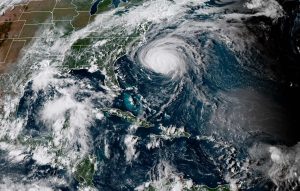1 August 2019
WASHINGTON – Current design standards for United States hydrologic infrastructure are unprepared for the increasing frequency and severity of extreme rainstorms, meaning structures like retention ponds and dams will face more frequent and severe flooding, according to a new study.
Extreme weather events are on the rise, but U.S. water management systems use outdated design guidelines. New research, published in the AGU journal Geophysical Research Letters, analyzed data from multiple regions throughout the U.S. and found the rising number of extreme storms combined with outdated building criteria could overwhelm hydrologic structures like stormwater systems.
The new study is particularly timely in light of recent storms and flash floods along the East Coast.
“The take-home message is that infrastructure in most parts of the country is no longer performing at the level that it’s supposed to, because of the big changes that we’ve seen in extreme rainfall,” said Daniel Wright, a hydrologist at the University of Wisconsin-Madison and lead author of the new study.

Hurricane Florence’s unprecedented rainfall caused extensive damage to infrastructure in North and South Carolina after it made landfall in fall of 2018.
Credit: U.S. Air Forces Central Command
Engineers often use statistical estimates called IDF curves to describe the intensity, duration, and frequency of rainfall in each area. The curves, published by the National Oceanic and Atmospheric Administration (NOAA), are created using statistical methods that assume weather patterns remain static over time.
“Design engineers at cities, consulting companies, and counties use this for different purposes, like infrastructure design management, infrastructure risk assessment and so forth. It has a lot of engineering applications,” said Amir Aghakouchak, a hydrologist at the University of California, Irvine who was not involved with the new study.
But climate change is causing extreme rainfall events to occur more often in many regions of the world, something IDF curves don’t take into account. One measure of extreme rainfall is the 100-year storm, a storm that has a one percent chance of happening in a given year, or a statistical likelihood of happening once in 100 years on average.
Wright and his colleagues wanted to know how existing IDF curves compare with recent changes in extreme rainfall. They analyzed records from more than 900 weather stations across the U.S. from 1950 to 2017 and recorded the number of times extreme storms, like 100-year storms, exceeded design standards. For example, in the eastern United States, extreme rainstorm events are happening 85 percent more often in 2017, than they did in 1950. In the western U.S., these storms are appearing 51 percent more often now than they once did.

On the left, each number and region correspond to the percent increase since 1950 in the number of daily rainfall measurements that should happen on average every 10 years (which hydrologists call “10-year storms”). On the right, each number and region reflect the percent increase since 1950 of day-long 100-year storms
Credit: AGU
The scientists found that in most of the country the growing number of extreme rainstorms can be linked to warming temperatures from climate change, although natural events, such as El Niño, also occasionally affect the Southeast’s climate.
By comparing the number of storms that actually happened against the number predicted by IDF curves, the researchers also showed the potential consequences for U.S. infrastructure. In some regions, for example, infrastructure designed to withstand extreme rainstorms could face these storms every 40 years instead of every 100 years.
“Infrastructure that has been designed to these commonly-used standards is likely to be overwhelmed more often than it is supposed to be,” Wright said.
The researchers hope the findings will encourage climate scientists, hydrologists, and engineers to collaborate and improve U.S. hydrologic infrastructure guidelines.
“We really need to get the word out about just how far behind our design standards are from there they should be,” Wright said.
— Written by Abigail Eisenstadt, AGU public information intern.
###
Founded in 1919, AGU is a not-for-profit scientific society dedicated to advancing Earth and space science for the benefit of humanity. We support 60,000 members, who reside in 135 countries, as well as our broader community, through high-quality scholarly publications, dynamic meetings, our dedication to science policy and science communications, and our commitment to building a diverse and inclusive workforce, as well as many other innovative programs. AGU is home to the award-winning news publication Eos, the Thriving Earth Exchange, where scientists and community leaders work together to tackle local issues, and a headquarters building that represents Washington, D.C.’s first net zero energy commercial renovation. We are celebrating our Centennial in 2019. #AGU100
*****
Notes for Journalists
This paper is freely available for 30 days. Journalists and public information officers (PIOs) can download a PDF copy of the article by clicking on this link: https://agupubs.onlinelibrary.wiley.com/doi/full/10.1029/2019GL083235
Journalists and PIOs may also request a copy of the final paper by emailing Nanci Bompey at [email protected]. Please provide your name, the name of your publication, and your phone number.
Additional information on the study can also be found at: https://www.engr.wisc.edu/treading-water-uw-madison-engineer-finds-increasing-storms-pose-infrastructure-challenge.
Neither this paper nor this press release is under embargo.
“U.S. hydrologic design standards insufficient due to large increases in frequency of rainfall extremes”
Authors
Daniel B. Wright: University of Wisconsin-Madison, Madison, Wisconsin, USA;
Christopher D. Bosma: University of Wisconsin-Madison, Madison, Wisconsin, USA;
Tania Lopez-Cantu: Carnegie Mellon University, Pittsburgh, Pennsylvania, USA.
Contact information for the researchers:
Daniel Wright, University of Wisconsin-Madison
+1 (608) 262-1978
[email protected]
Nanci Bompey
+1 (202) 777-7524
[email protected]